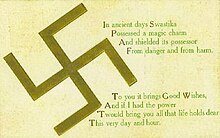
The swastika (from Sanskrit svástika) is an ancient Eurasian religious symbol that generally takes the form of an equilateral cross with four legs each bent at 90 degrees in either right-facing (卐) form or left-facing (卍) form.[2][3] It is considered to be a sacred and auspicious symbol in Hinduism, Buddhism, and Jainism and dates back at least 11,000 years.[4]
The swastika (gammadion, fylfot) symbol became a popular symbol of luck in the Western world in the early 20th century, as it had long been in Asia, and was often used for ornamentation. The Nazi Party adopted the symbol in the 1920s,[5] and its use in Western countries faded after the Nazi association became dominant in the 1930s.[6] In recent decades many public swastikas have been removed or covered over, although some have been retained.
- ^ "Good Luck Swastika". CardCow.com.
- ^ Goblet d'Alviella (1894). The Migration of Symbols. London: A. Constable and Co.
- ^ Press, Cambridge University (10 April 2008). Cambridge Advanced Learner's Dictionary. Cambridge University Press. ISBN 9783125179882 – via Google Books.
- ^ Beer, Robert (1 January 2003). The Handbook of Tibetan Buddhist Symbols. Serindia Publications, Inc. ISBN 9781932476033 – via Google Books.
- ^ "History of the Swastika". United States Holocaust Memorial Museum. Retrieved 9 May 2018.
- ^ Mukti Jain Campion (23 October 2014). "How the world loved the swastika - until Hitler stole it". BBC News.